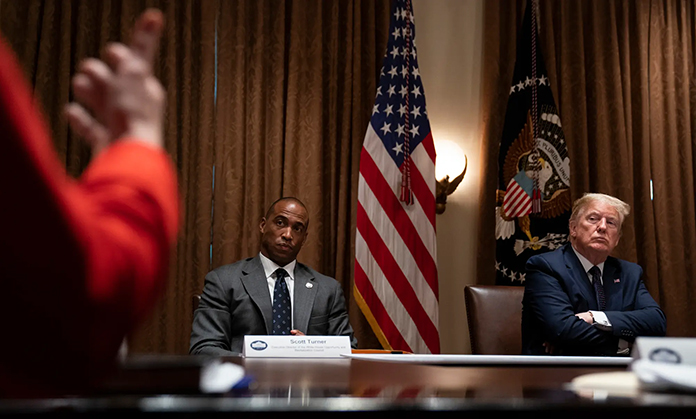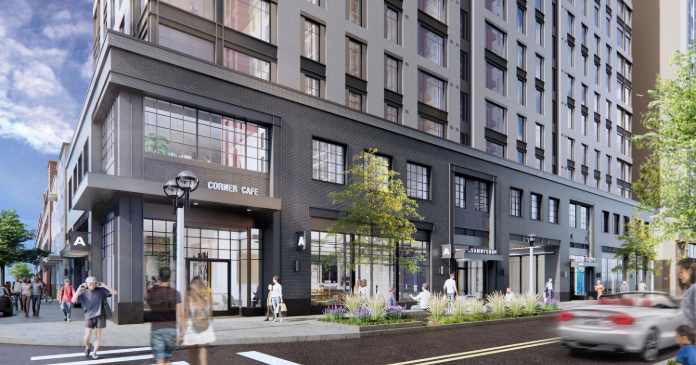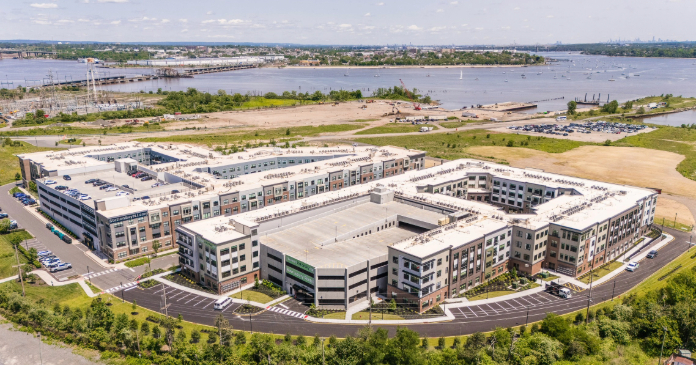Like the story line of a Brad Pitt movie, New Orleans is an epic parable of man versus environment. Last month, the twice-named Sexiest Man Alive by People magazine, swept into town to shine the spotlight and rev up resources for the devastated city.
What he discovered was that many areas have yet to recover even a year later. More than half of New Orleans remains empty with scores of abandoned houses, shops, offices, schools, and churches. “I was not prepared,” the actor said, describing how he drove for miles only to see street after street of devastation.
“There’s a big opportunity here,” Pitt said, to rebuild the city using energy-efficient building materials and appliances that would improve quality of life, particularly in low-income communities.
Indeed, New Orleans is a live case study on massive re-construction and a fertile ground for reform.
Hurricane Katrina was the costliest, most deadly hurricane in the history of the United States. As it hit the Gulf Coast in August, 2005, it was the sixth-strongest Atlantic hurricane ever recorded and the third-strongest land falling. It flooded over 80 percent of the city.
The calamity is now an indelible chapter of knowledge, as the local debate simmers on how to effectively rebuild the city.
A massive rebuilding and far-reaching social dynamic have also made the Big Easy an inevitable focus for environmental campaigns such as green building. The timing may be ideal.
Green, energy-efficient design has begun to show economic teeth, capture market share, and gain serious credibility among residential builders. Momentum builds as voices from all sides of the table herald the economic and social value of green.
Hollywood celebs, like Brad Pitt, Leonardo DiCaprio, and Kate Bosworth are throwing their star power behind the rally for more green construction in the U.S. just as the ideology is trading its organic tie-dye for a mainstream collar.
Green building is on the fast track to becoming the next big thing for large-production, residential builders. Developers say they are building green because they believe in it, but they also expect to gain a competitive edge. If faced with the choice of renting or buying two similar apartments, developers say, consumers increasingly will opt for the one with green features, even if it comes at a higher price.
“We think it’s important to do, and we think that other buildings that don’t do this will become obsolete, and our buildings will continue to maintain their value,” said Douglas Durst, who built 4 Times Square in New York, a pioneering green office building, in the late 1990’s. He is now building his second green apartment tower.
The National Association of Home Builders (NAHB) says that builders producing environmentally responsible homes rose by 20% in 2005, and that number is expected to grow by another 30% this year.
First Lady Laura Bush spoke to a gathering of National Design Award honorees last month urging them to become involved in the Gulf Coast re-build. Their legacy, she said, would be found in their efforts to improve the devastated region. She also added that Hurricane Katrina “gives us the chance to build green buildings and to build energy-saving buildings.”
Once lacking architectural sophistication, fiscal feasibility and wide consumer interest, green building was attractive in principle, but a challenge to apply.
Yet, as consumer demand sets its own economic priority, so too has a spattering of green buildings evolved into entire communities sprouting up across the country.
Going green — energy-efficient, water-conserving buildings full of features that value natural over chemical, recycled over new and renewable over disposable — is firmly in play in consumers’ minds and builders’ hearts.
Most are already familiar with the benefits of green building from the workplace. Having made its way into office construction years ago, corporate America began to notice less absenteeism; less time lost to asthma, allergies and other illnesses aggravated by mold, stale air and chemicals found in many conventional buildings.
Whether for health, global responsibility, or market share, a new affluent consumer category is building momentum in today’s market and it’s pressing green building into the multi- and single-family residential markets at a rapid clip.
“LOHAS,” or Lifestyle of Health and sustainability, is one of the latest consumer groups that builders are responding to with new and renovated green product.
Thought to include over 40 million adult consumers, the value of the LOHAS market is estimated at $200 billion according to David Brotherton, a Seattle consultant in corporate responsibility. This includes goods and services ranging from eco-vacations to green homes.
“There’s a lot more consumer interest. It’s starting to be a groundswell,” says Calli Schmidt for the National Association of Home Builders (NAHB) in Washington. Green building will reach a “tipping point” next year as two-thirds of all builders will build green homes according to a McGraw-Hill construction survey.
Environmentalism ebbs and flows within American politics, but green building has permeated the U.S. legislature.
The Energy Policy Act of 2005 offers federal tax credits of $1.80 per square foot on all projects that meet ASHRAE standards (American Society of Heating, Refrigerating and Air-Conditioning Engineers). Other legislation gives businesses up to 10 percent tax credit for employing solar and geothermal technologies. The Department of Energy also hands out grants for businesses that experiment with new energy-efficient technologies.
The United States Green Building Council created a rating system called LEED, short for leadership in Energy and Environmental Design, to measure the degree to which buildings incorporate green practices and materials. Four states and 17 cities offer incentives for LEED-rated buildings.
Chicago, Pasadena, Calif., and several other cities now fast-track permits for builders who commit new construction to green standards. The federal government, 15 states and 46 cities require new public buildings to meet LEED standards.
The Green Building Council has certified over 550 buildings across the country since 2002. Cities seeking to acquire LEED designations for large, mixed-use projects literally span the country: Pasadena, Milwaukee, Austin, Des Moines, Boise and Spokane, Wash. The council has recently begun work on establishing LEED standards for multi- and single-family housing.
Multi-billion-dollar redevelopments in Camden, N.J. and New York City are going green. Seattle has the nation’s first green public-housing project, 600 apartments and townhouses surrounded by market-rate green houses. At least 5,000 units of green low-income housing in 25 states have gone up in the past 18 months.
Developers say that features necessary for a gold LEED rating generally add 6 to 8 percent to the cost of a building. In the case of One Rockefeller Park, J. Christopher Daly, the president of Sheldrake, said that he expected to spend an additional 8 percent, or $18 million, for the building’s green elements, which include an unusual double-glass wall that provides an added level of insulation.
The long and winding road: Global Green makes connections
Brad Pitt used New Orleans’ reconstruction to promote his competition for an ecologically-sound architectural design to be used as a model from which to rebuild the city. Pitt, along with Santa Monica-headquartered, Global Green USA, selected six finalists last month, and on the anniversary of the hurricane, announced the first place winner.
When founding Global Green’s parent company, Green Cross International, Mikhail Gorbachev set out to cure three global ills: eliminate weapons of mass destruction, ensure access to clean water for all of humanity, and combat global warming. Gorbachev has always been an avid environmentalist and the fallout from the Chernobyl disaster affected him deeply.
Leader of the Soviet Union from 1985 to 1991, Gorbachev’s greatest notoriety stems from his part in ending both the Cold War and the supremacy of the Communist Party, as well as the subsequent dissolve of the Soviet Union. For his efforts, he won the Nobel Peace Prize in 1990.
In 1993, Gorbachev began Green Cross International. That same year he met American activist Diane Meyer Simon and invited her to join his endeavor.
Diane had spent decades as a political staffer, strategist and philanthropist; twelve years of which she worked for U.S. Senator Birch Bayh.
Like many of her time, her life was set on course one night in 1968 as she waited for hours to hear Bobby Kennedy speak. Kennedy did arrive, only to announce the assassination of Martin Luther King.
For Diane, the night dawned a conviction that would forever ascribe her to “humane politics.” Diane organized audio and video footage collected from the evening into a blended production, creating a permanent historical archive.
Diane recalls, “For the first time in history, the world could hear and see Bobby Kennedy as he calmed an integrated, frightened and furious crowd and view the majesty in those moments of terrible, swift truth.”
Diane also carries ties to real estate through her husband, Herbert and his brother, Mel, who own Simon Property Group. The company’s holdings include shopping malls throughout the Midwest,as well as the development of Minnesota’s mammoth Mall of America. Until recently, Herbert was on the Forbes 400 list; from last estimates, his net worth was $335 million.
Through Diane’s work as activist and philanthropist, she crossed paths with Matt Petersen who had run a number of political campaigns with which Diane was involved. Finding a kindred spirit, she brought Petersen on in 1994 from another environmental group to head Global Green as CEO.
Petersen, a Northern California boy from Modesto, quickly mastered the local Hollywood currency of connections, and began to harness local star power to get his message of green living to the masses.
From his Santa Monica office, Petersen set his sights on the Oscars. Understanding the power of celebrity on the American market, he provided Oscar-bound stars with hybrid cars, such as the Prius. The effort gained exposure for the energy-saving vehicles and gave green transportation a sleek, Hollywood finish.
His message: hybrids are fun to drive — even sexy, as Will Ferrell put it — as well as a smart solution to reducing U.S. dependency on
oil.
To celebrate Earth Day, a high holiday for environmentalists, Petersen orchestrated a field trip to Frobisher Bay, a town of 6,800 at the edge of the Artic Circle. As Canada’s only Inuit (Eskimo)-controlled territory, his all-terrain caravan carried California politicians, business leaders, and celebs Salma Hayek and Jake Gyllenhaal to the edge of the known world.
Their mission: to visit a community where rising temperatures threaten an ancient culture — and orchestrate a large-scale aerial photo op. Hayek, Gyllenhaal and more than 500 Iqaluits, mostly children, sat in the frigid wind at Rotary Park on a vast expanse of snow-covered ice, to spell out “Arctic Warning,” and the Inuit word for “Listen.”
This was the brainchild of artist John Quigley who once made headlines for camping out 71 days in the branches of a 400-year-old California Redwood to keep developers from cutting it down.
Indeed, the world of celebrity promotion can be precarious as the green movement works to shed its Bohemian alter ego to adapt to mainstream.
Petersen scouts out celebs who display a life exemplary of wholesome green living. As stardom is often fraught with excess, someone who drives a gas-guzzling Hummer, for instance, would pose a bit of a conflict as an environmental spokesman.
And Petersen has discovered that the rich and famous are not always reliable: Adrien Brody bailed on the Artic gig just a week prior. Still others are booked: Bono had a concert in Denver according to an event organizer, and Leonardo DiCaprio couldn’t extricate himself from a film shoot.
Finally, green recruits need to know something about the issue they’re embracing. Celebs who are nice with a significant following score bonus points for the green team.
“The question is,” says Petersen, “in an age and culture that’s celebrity-obsessed, how do you, in a smart and savvy way, use celebrities to shine the light on the science, on the facts and on the solution?”
Paul Schervish, director of the Boston College Center on Wealth and Philanthropy sees a trend. “We’re finding a new era: as more prominent people give to charity, more will put it on their agenda,” says Schervish. “They respond to social expectation.”
Brad Pitt’s partner, Angelina Jolie, is a goodwill ambassador for the U.N. high commissioner for refugees. She has a passion for the plight of refugees, among other issues, and has encouraged celebrity activism.
When Jolie uses her celebrity, “others say, ‘Gee, this is a great thing to do, and look at all the good it produces,'” said Marc Pollick, director of the Giving Back Fund, a non-profit organization that advises celebrities on philanthropy. “I think the copycat behavior is fabulous. It’s sort of a tide raising all the boats.”
“As all forms of philanthropy are becoming more prominent — donations and the people involved are becoming more substantial — this has taken on a life of its own. Celebrities are compared with each other on how much they’re doing,” Schervish said.
Stars do seek similar recognition for their charity work, Pollick notes. “They’re competitive. It’s a good thing and it’s worked. They have become role models.”
Indeed, we live in a culture that is celebrity-obsessed and as they go, so do the hearts and minds of significant market share. Which brings the spotlight to Petersen’s, by far, largest catch to date: Brad Pitt.
Petersen met Pitt at a Clinton Global Initiative a year ago. As fate would have it, Pitt was in negotiation on his next film, The Curious Case of Benjamin Button with Paramount Pictures and Warner Bros. The film, along with a huge production budget, was set to film in New Orleans.
“Brad and I talked about what we wanted to do here individually and collectively,” said Peterson. By April, Pitt had committed to underwrite $100,000 to Global Green’s New Orleans effort, and signed on as head of jury for the green design contest.
Pitt, Peterson, and a judging panel, composed mostly of architects, chose five finalists and an honorable mention from multifamily entries that used renewable resources, solar power and other green strategies.
The curious case of Brad Pitt
Brad Pitt, 42, may give the appearance of a Gen X slacker, but his mid-Western upbringing shines through in a strong work ethic and earthy charm. Raised in Springfield, Mo., Pitt’s avid interest in architecture really didn’t surface until later.
Pitt studied Journalism at the University of Missouri, Columbia, with a focus on advertising; he left college two credits short of graduation to move to California.
He did not set out to be the definitive leading man and doesn’t consider himself one now, even if Pitt does earn as much as $20 million per picture. As the Hollywood adage goes, one of every two scripts is written with him in mind. Speaking with Pitt, you get the sense that although he is serious about his craft, he is careful not to believe his own press.
While travels have taken him around the world, including Western Africa for the birth of his third child, a daughter, Shiloh, with partner, actress, activist and ambassador, Angelina Jolie, 37, he and his family have recently returned to Southern Calif.
Both have a number of projects lined up, including Jolie in Sin City II and the role of the wife of murdered Wall Street Journal reporter Daniel Pearl in A Mighty Heart. Pitt’s production company, Plan B, owns the story rights. Pitt had originally earmarked the part for first wife Jennifer Aniston, from whom he has since divorced. Insiders say Jolie insisted she be given the part of Mariane Pearl — which is already being tipped as potential Oscar-winning material.
In the meantime, Pitt and Jolie are building a seven-bedroom home in Missouri a quarter mile from Pitt’s parents, Bill and Jane in Springfield.
While expanding the family with another adoption is foremost on Jolie’s mind, Pitt continues to focus on solidifying the union through marriage.
Meanwhile, the power couple live life under a pressurized public gaze and continues to dodge speculation of every type.















